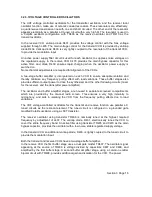
3.2.4.7
SERIAL CONTROL BUS
The serial control bus is used for control of the following devices; EEPROM, display driver,
CTCSS encoder/decoder, serial latch and the RF synthesizer. Each of the serial devices is
accessed by asserting an enable line and then serially clocking the data into the chip.The
control of each device is as follows:
3.2.4.7.1
EEPROM
IC203 is an electrically erasable programmable read only memory which contains the
configuration information of the mobile independent of any power supply. Apart from the
microprocessor, the EEPROM is the only device on the serial data bus which is able to both
send and receive data. The 9- and 64-channel variants have a 256 byte and 512 byte device
respectively. The devices are configured as 128 by 16 and 256 by 16 respectively but as they
are communicating with an 8-bit micro controller, the control program treats the devices as 8-
bit arrays.
When programming the EEPROM, as occurs in initial configuration of the equipment, the
following steps occur. First the EEPROM is sent a write enable command. This consists of the
enable line to the device going high and then the write enable command is clocked into the
device using the serial clock and data lines. 9 bits of data are clocked in. The enable line is
then returned low.
Next, the data to be written to the EEPROM along with the program command is clocked into
the device. This consists of 28 bits of data and command information. While the device is
internally programming, the data out line (serial data) indicates the state of programming. This
data out line is low while programming and high when programming is completed. This
programming typically takes 5 to 10 mSec. When all this is finished, a write disable command
of the same form as the write enable command is issued to the device. Reading of the data in
the EEPROM is accomplished by setting the enable line high and then clocking in the read
command and address.
Next the data of that location is clocked out, and the enable line is then returned to 0. There
are 4 different read modes used in the PRM80. When reading a byte then only 8 bits of data
are clocked out before de-selecting the device. When reading 16 bits then the whole 16 bits
are clocked out.
When reading channel data the read command, address and then 48 bits of data are clocked
out. When changing channel and an invalid channel is selected then only the read command,
address and two bits of data are clocked out. If the channel data is valid then the 48 bits of
data will be clocked out.
3.2.4.7.2
Display Driver
The display driver, IC100, is the same for both the 9- and 64-channel variants. The display IC
is programmed by first setting the enable line high and then clocking in 21 bits of serial data
using the clock and data lines. The enable line is then returned to the low level. Two groups of
data are required for the display driver, one group for each back plane of the LCD. The 9-
channel device only utilises one back plane so there will only be one group of data sent to
Section 3 Page 24
















































